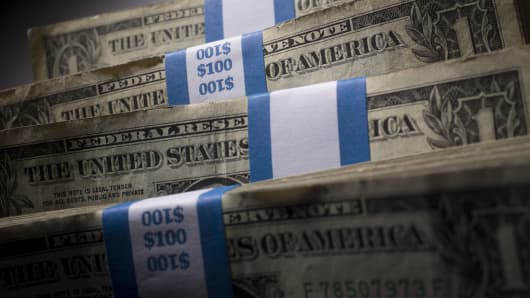Expectations of an end to ultra-easy U.S. monetary policy are likely to set in during the second-half of 2013, triggering a bull run in the dollar that could last for five years, says independent economist Andy Xie. And this, he argues, could lead to a "crisis" in emerging markets as hot money inflows unwind.
The U.S. economy has begun to show signs of life again - with factory activity touching a nine-month high in January - prompting talks about an end to the Federal Reserve's quantitative easing program.
Xie forecasts the dollar index – which measures the performance of the greenback against a basket of currencies - will rise to 100 in the next three years, a 25 percent rise from current levels around 80 on relative strength in the world's largest economy.
"The dollar bull market tends to trigger crises in emerging economies. This time is likely to be the same," the former Morgan Stanley economist said, citing the Latin American debt crisis in the 1980s and the Asian Financial Crisis in 1997, during which a rise in the U.S. dollar against local currencies led to a spike in interest payments on external debt.
"During the last ten year's dollar bear market, massive amount of hot money flowed into emerging economies, causing currency appreciation, asset bubbles.(But) when the dollar turns the direction, so does the liquidity. The virtuous cycle on the way up becomes a vicious one on the way down," he added.
(Read More: Flee 'Safe' Sovereign Debt, Says Hasenstab )
In the dollar bear market of the past decade, the BRIC (Brazil, Russia, India, China) countries have been the "darlings" of international speculative capital, making the them most vulnerable, according to the well-known economist. He did not provide targets for the BRIC currencies.
He said Brazil and India are most at risk among the BRIC countries because their capital markets are most open to foreign investment.
"A big worry this time is the hot money flowing in to local currencies, local currency debt by the big hedge funds, they were not there 15-20 years ago, they are planting money into emerging economies by buying local government debt," Xie said.
In Brazil, there is a high level of involvement by foreign investors in the country's local currency bond market, he said. Foreigners hold around 12.3 percent of the country's domestic debt, according to Reuters.
(Read More: Unlikely Market ScenariosCould Spring on Us in 2013)
While in India, foreign investors play a critical role in the country's stock market, contributing to around 30 percent of market turnover. Last year, foreign institutional investor inflows (FII) into the country's equity market, for example, touched $23 billion – the second highest net inflow in a single calendar year.
"When the dollar strengthens, these trades will unwind. This will trigger the emerging market currencies to go down, inflation to go up, and interest rates to go up, and then government bond prices will decline," Xie said.
Emerging Market Fundamentals Strong
Other analysts say that emerging market economies are in a stronger position than in the past and that should offer some protection against a sharp unwinding of foreign funds should the dollar start to rise amid an unwinding of the Federal Reserve's quantitative easing program.
Dariusz Kowalczyk, senior economist and strategist, Asia ex-Japan and Credit Agricole, disagrees that the emerging market currencies will be vulnerable, given the robust fundamentals of their respective economies.
"While we expect the U.S. dollar to gain against the euro and yen over the next two years, we believe emerging market currencies will appreciate against the dollar," he said.
Historically, when the dollar falls against major currencies, it has also declined against emerging market currencies, but this time around will be different, he said.
"Emerging markets are growing faster; they will attract inflows into the economies, equity and corporate bond markets, which will underpin their currencies. They will also attract reserve diversification inflows," he said.
Three years from now, Credit Agricole expects the Indian rupee and Brazilian real will trade at 49.4 and 1.88 against the U.S. dollar, from 53.3 and 1.99, respectively. This marks gains of 7 percent for the rupee, and 5.5 percent for the real.
(Read More: Here Are 4 Factors That Could Pull the US Dollar Down )
If there is a strong resurgence in the U.S. economy and the Fed subsequently raises interest rates at a faster-than-expected pace – making the interest rate differential less attractive – this emerging market currencies could come under some pressure, Kowalczyk said, adding that he does not foresee this situation playing out.



